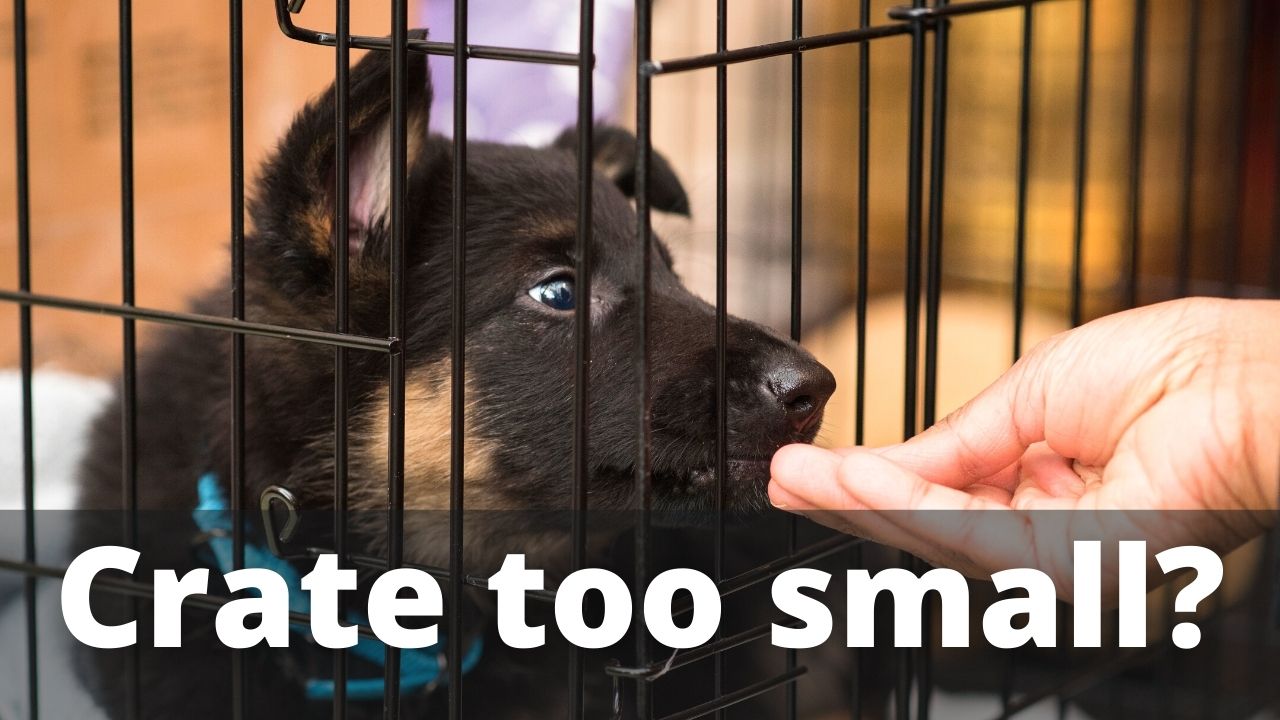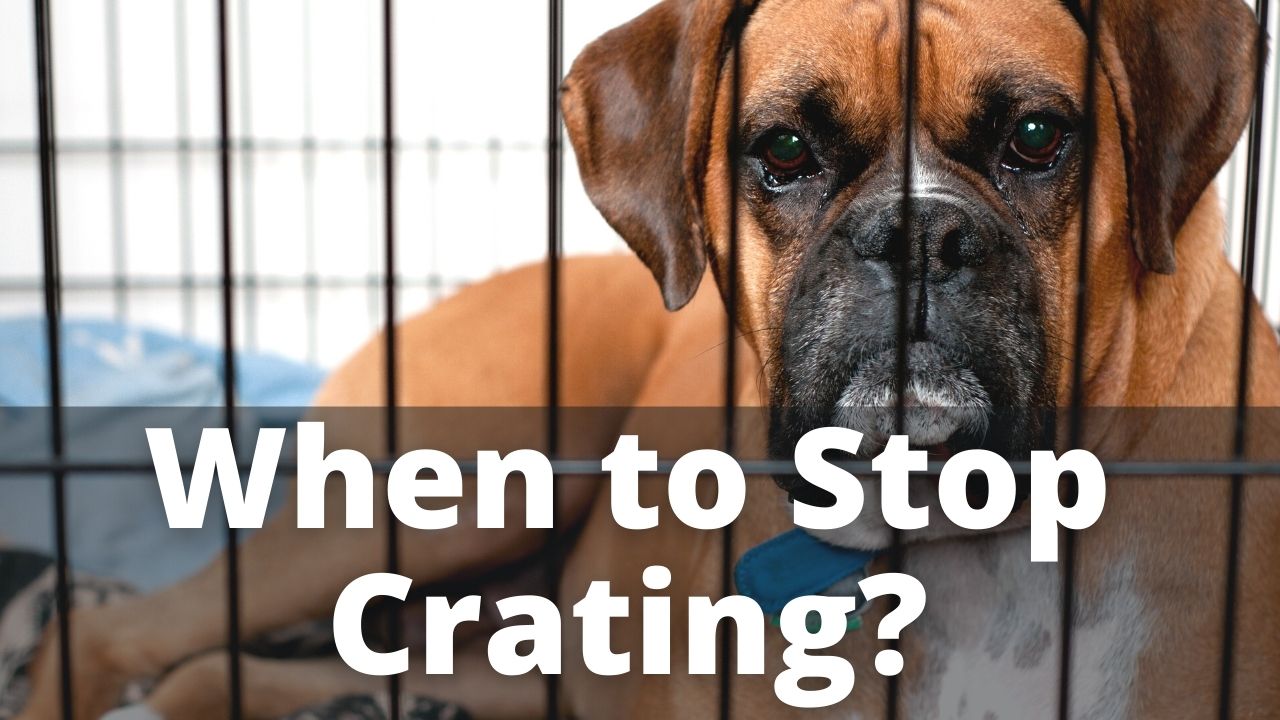Depending on how big your puppy will be when full grown, they may need a much bigger crate as an adult than when you first brought them home. But how do you know when your puppy has outgrown their crate? What is the right size of a crate, anyways? And should your puppy stop using their crate? We’ll give you all the answers in this article.
Do puppies outgrow their crate?
Most puppies will outgrow their crate. At the very least, they will often outgrow the amount of room they are given within their crate. Traditionally, a puppy needs enough room to stand up, turn around, and lay down without any extra room for them to urinate or defecate in a separate area from where they sleep.
For some dogs, you may be able to purchase a crate ideal for their puppy and adult size by using a crate divider (often a wire panel that can be used inside a wire crate) or even a box or similar large object to restrict the amount of space.
This is definitely the most economical option and saves you from having to buy multiple sizes of crates over the life of your puppy.
Some dogs may also not change as drastically in size from puppy to adult. For example, a Papillon is a breed of dog that only weighs about 5-10lbs as an adult. While they are smaller than other breeds at birth, they won’t grow so dramatically that they necessarily require a different crate as an adult.
Rather, you could purchase a crate that is slightly bigger than necessary for your small breed puppy – proving they are not having potty training issues that would be helped with a smaller crate – and then your puppy could grow into it with age.
Other breeds, like a Great Dane, will grow a huge amount from puppy to adult. In most cases, a Great Dane puppy would need a smaller crate (or a crate sectioned into a smaller area) when they are young and then a larger crate once they are fully grown.
So, if you are using the crate as a small area to keep your puppy contained, without the option to pee in one corner and have room to sleep in another, you will likely need to expand the size of their crate as they grow.
However, if your puppy has excellent potty training skills and you want to save money on future crates, you can always purchase a larger crate with the ability to restrict the size with a crate divider if necessary.
There are, of course, many ways to contain puppies and practice potty training skills other than a crate. Many trainers are finding the use of an exercise pen (sometimes with pee pads or a litter box) to be an excellent alternative, especially for dogs that have negative feelings associated with the crate.
And if your puppy doesn’t like their crate, we have this article: Puppy Doesn’t Like Crate: (Why and What to do)
Thus, depending on your goals for crating your puppy and how often you plan to use it for longer periods of time, you may not find a smaller space to be beneficial when your puppy is younger.

Is my crate too small?
Crates should allow, at a minimum, enough room for the puppy to stand up, turn around, and lay down. The puppy should be able to do this without restriction.
For example, when your puppy is sitting or standing, they should be able to do so without crouching or holding their head lower than normal.
It’s uncomfortable for a dog to not be able to fully sit or stand and stretch their neck to a normal position, so ensure the crate has enough height for their head to be in a natural position when standing (and not just enough room for their back to clear the ceiling while their head is held low).
Your dog should also be able to turn around without contorting themselves to do so. They might brush a nose or tail briefly against the side of the kennel, but it should not take too much effort to turn.
If your dog can’t comfortably have space to turn around, they may hold themselves in awkward positions which can lead to physical concerns, as they hold their body in the same position for a long period of time.
If you’ve ever spent too many hours sitting in a desk chair, you likely know the feeling. Even the comfiest chair can lead to soreness when you don’t move often enough.
It’s also important, especially if the crate is to be used for any length of time, that your dog can lay on their side and comfortably extend their body.
You’ll want to avoid crates where your dog’s body has to be curved in order to fit, at least as a general rule of thumb for crates where your dog will regularly be spending time.
A crate with less space may be safer for traveling (less room for the dog to be tossed around within the crate in case of an accident). Or, if used for a short period of time at an event or other similar location, a slightly smaller crate may be used for convenience without too much concern.
For my own dogs, I have several sizes of crates. One crate is plastic and is a crate used by previous dogs, so it was convenient to continue to use. It fits both dogs, although the larger one fits without as much stretching room, so it’s not used regularly.
Instead, I have a larger wire crate that allows the biggest of my dogs to stretch completely, which is important to me especially because he often stretches out fully to sleep. While neither dog spends regular time in the crate anymore, the larger crate definitely was a better choice when he was crated while I was gone at work for hours at a time.
This post may help you if you need to leave your dog for long stretches of time: Leaving Your Dog Home Alone: (8…12…24-hours)
I also have two soft-sided crates for convenience when traveling. One is the slightly smaller size, and one is the bigger size.
If both dogs will be crated separately and for any significant length of time, they each get their own crate, with the smaller dog in the smaller crate so they are of appropriate sizes for each dog.
However, if I just need a crate to temporarily hold them while I’m moving props for a dog training demonstration, or while I walk the rally or agility course before competing, I often just bring the larger crate and both of them share it.
They’re comfortable with this, and only crated for short periods of time, and the larger crate gives them both room to lay down (although maybe not stretch out as fully as if they were by themselves).
As you can see, the situation in which you are crating your dog also matters when deciding if your crate is too small. Crates that will be used for a large portion of the day or night at a time should have more room for laying down and stretching than a crate that might be used only for a few moments.

When to stop using a crate for a puppy
There is no magic moment when you should stop using a crate for your puppy. Whether or not to continue crating your puppy depends on if your puppy is potty trained, if they will be content and comfortable out of their crate, and if there is a safe place for them where they can’t eat or destroy things they shouldn’t.
For my older dog, he was usually crated overnight until he was around 9-10 months old. He did have moments of getting into things he shouldn’t around the room, but nothing was left out that was inherently dangerous.
And I was willing to replace the occasional notebook or phone charger in exchange for puppy snuggles!
It wasn’t until he was about a year and a half old that he was left out of the crate during the day while I wasn’t home. He was still confined to one room, but had more freedom than the crate.
My younger dog has spent minimal time in the crate since he came home to me at 6 months old. This was not my preference – he had some strong feelings about being crated and wanted to make sure everyone heard, which was not ideal living in an apartment!
Instead, I used tethers and an exercise pen to control his environment so he was comfortable and couldn’t access anything dangerous.
We’ve worked on crating and he can often be content and quiet in the crate while the dogs are taking turns training or demoing. However, I haven’t needed it for him to prevent destruction or help with potty training, so he’s not crated on a regular basis.
So the answer to when a puppy should stop crating will be it depends on if your dog likes their crate and if you have a use for the crate. If you use the crate to get your dog out of the way, or if a guest is coming over, you can also use the option of place training. Which does the same thing, and you can read about that here.
What age should a puppy be out of the crate at night?
There’s no specific age that dictates when your puppy should be out of the crate at night. The timing varies with your individual puppy and individual experiences.
Puppies that potty train quickly, are not destructive chewers, and are likely to sleep through the night, can often sleep out of the crate quicker than puppies that enjoy more mischief in their lives.
Instead of considering a specific age, watch for the signs that your puppy is ready to sleep out of the crate.
Your puppy is ready to sleep out of their crate only when several conditions are met. Some of these require you to take certain actions, and others rely on the maturity of the dog.
If your puppy is likely to have accidents, they should not have free rein of a room at night. Restricting space helps with potty training, so whether you are doing so with a pen, tether, or crate, it’s important your puppy has a basic understanding of potty training first.
Your puppy won’t have full bladder control until 4-6 months old, so keep that in mind as you decide if your puppy is ready to sleep out of their crate.
It’s also critical that the environment is safe for the puppy. If you are in a small apartment and have to store a variety of things in your bedroom, you may need to restrict your puppy’s access to things while you sleep to keep them safe.
If accidents are no longer a huge concern, and if the environment is safe for an unsupervised puppy (you can’t supervise while sleeping!), then you can consider letting your puppy sleep out of their crate (or, out of their pen or off their tether).
You may go back and forth between contained and free within the room as your puppy grows up too, and that’s normal. Puppies go through adolescence and you may find that your puppy has a sudden interest in things they previously ignored and they need more boundaries to keep them safe again.
It’s also fine if your puppy continues to sleep in their crate. If they are comfortable in their crate, and it’s an appropriate size, then it’s more than fine to keep them crated at night.
One of my dogs regularly chooses to sleep in his crate if it’s available and the door is open just because he likes it, so for him (and similar dogs), sleeping out of the crate at night doesn’t have to be a necessary goal.
Are you interested in reading: Puppy Pees in Crate: What to do…




